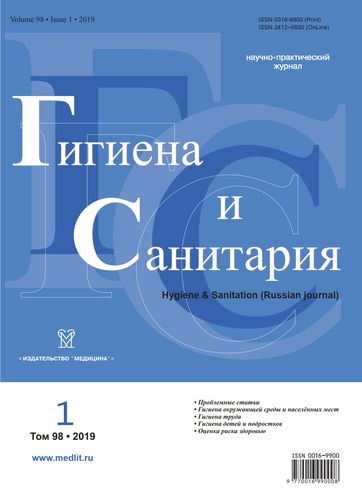Methodological features of health risk assessment in acute inhalation effects on the population
- Authors: Kislitsyn V.A.1, Shashina T.A.1, Dodina N.S.1
-
Affiliations:
- Centre for Strategic Planning, Russian Ministry of Health
- Issue: Vol 98, No 1 (2019)
- Pages: 87-89
- Section: HEALTH RISK ASSESSMENT
- Published: 14.10.2020
- URL: https://ruspoj.com/0016-9900/article/view/640191
- DOI: https://doi.org/10.47470/0016-9900-2019-98-1-87-89
- ID: 640191
Cite item
Full Text
Abstract
Risk assessment of acute inhalation effects on the population has methodological features at all stages of the research. When choosing priority substances, a modification of the method for calculating the relative hazard index by the emission value (in g/sec) is proposed. To assess acute risk, 1-hour averaging of concentrations coinciding in duration with reference levels of acute inhalation effects (ARfC) is used. The use in modeling program of a maximum hourly emission value for each source results in an unreasonable overestimation of the values of 1-hour concentrations. The standard parameters of the emission sources from the report on permissible emissions ( PDV) do not provide the data for the mode of sources (on/off), the actual emission rates (g/sec) for each hour, and other parameters that specify the sources operation. Recommendations were developed for calculation of 1-hour concentrations close to real, in assessing the exposure, structure, and format of the additional data and a computer package for the data connection to AERMOD and ISCST3 models, as well as for the truncation of the time series of calculated 1-hour concentrations at 95-98th percentile. Features of the acute risk indices calculation — coefficients (AHQ) and indices (AHI) are described. Using the hourly values of the time series of concentrations the highest AHQ value is determined at each exposure point, which is used to estimate the level of acute risk from a substance. To calculate the hazard index (AHI) of the substances affecting the same critical organs/systems, the AHQ hourly values of individual substances are summarized at each exposure point, the highest AHI value is determined, which is used to assess the level of acute risk from exposure to substances with unidirectional action. The approbation of the described methodical approaches has shown their effectiveness in determining the values of exposures and risks close to real values. Their use has reduced the values of AHQ and AHI acute risk indices to "plausible" values by 2 and 3.7 times, respectively.
About the authors
V. A. Kislitsyn
Centre for Strategic Planning, Russian Ministry of Health
Author for correspondence.
Email: noemail@neicon.ru
ORCID iD: 0000-0002-6575-2882
Russian Federation
Tatyana A. Shashina
Centre for Strategic Planning, Russian Ministry of Health
Email: sta815@mail.ru
ORCID iD: 0000-0002-4190-0326
MD, PH.D., leading researcher of Centre for Strategic Planning, Russian Ministry of Health, Moscow, 119991, Russian Federation.
e-mail: sta815@mail.ru
Russian FederationN. S. Dodina
Centre for Strategic Planning, Russian Ministry of Health
Email: noemail@neicon.ru
ORCID iD: 0000-0001-6693-922X
Russian Federation
References
- Guidance on the human health risk assessment under the influence of chemical contaminants. P 2.1.10.1920-04. Moscow: Federal Center of Sanitary Inspection Ministry of Health of Russia; 2004. (in Russian).
- User’s Guide for the AMS/EPA Model AERMOD. EPA-454/B03001; 2004.
- User’s Guide For The Industrial Source Complex (ISC3) Dispersion Models. Vol.1. EPA-454/B-95-003a. U.S. Environmental Protection Agency Office of Air Quality Planning and Standards Emissions, Monitoring, and Analysis Division, Research Triangle Park, North Carolina 27711; 1995.
- Recommendations on the design and content of the draft standards of maximum permissible emissions into the atmosphere (PDV) for enterprises. Available at: http://docs.cntd.ru/document/420284408/ (accessed August 1987). (in Russian).
- Avaliani S.L., Balter B.M., Balter D.B., Revich B.A., Stal’naja M.V., Fominskaja M.V. Health risk analysis of the air pollution from 15 oil refineries. II. Source types and spatial factors. Environmental protection in oil and gas complex. 2015; 3: 17-22. (in Russian).
- Onishhenko G.G., ed., Novikov S.M., Rahmanin Ju.A., ed., Avaliani S.L., Bushtueva K.A. Fundamentals of health risk assessment in exposure to chemicals that pollute the environment Moscow: RI of Human Ecology and Environmental Hygiene; 2002. (in Russian).
- Novikov S.M., Avaliani S.L., Andrianova M.M. Ponomareva O.B. The main elements of health risk assessment (manual for workshops). Moscow: Consulting center for the assessment of risk; 1998.
- The calculation methods of emission dispersion of pollutants in the ambient air. Available at: http://docs.cntd.ru/document/456074826/ (accessed August 2017). (in Russian).
- Novikov S.M., Shashina T.A., Skvorcova N.S. Principles, criteria and methods for assessing the short-term effects of the chemical air pollutants. Vestnik RAMN. 2006; 5: 3-7 (in Russian).
Supplementary files









